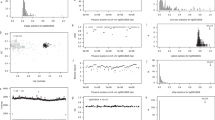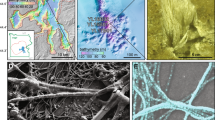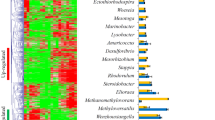Abstract
Deep-sea hydrothermal vent chimneys harbor a high diversity of largely unknown microorganisms. Although the phylogenetic diversity of these microorganisms has been described previously, the adaptation and metabolic potential of the microbial communities is only beginning to be revealed. A pyrosequencing approach was used to directly obtain sequences from a fosmid library constructed from a black smoker chimney 4143-1 in the Mothra hydrothermal vent field at the Juan de Fuca Ridge. A total of 308 034 reads with an average sequence length of 227 bp were generated. Comparative genomic analyses of metagenomes from a variety of environments by two-way clustering of samples and functional gene categories demonstrated that the 4143-1 metagenome clustered most closely with that from a carbonate chimney from Lost City. Both are highly enriched in genes for mismatch repair and homologous recombination, suggesting that the microbial communities have evolved extensive DNA repair systems to cope with the extreme conditions that have potential deleterious effects on the genomes. As previously reported for the Lost City microbiome, the metagenome of chimney 4143-1 exhibited a high proportion of transposases, implying that horizontal gene transfer may be a common occurrence in the deep-sea vent chimney biosphere. In addition, genes for chemotaxis and flagellar assembly were highly enriched in the chimney metagenomes, reflecting the adaptation of the organisms to the highly dynamic conditions present within the chimney walls. Reconstruction of the metabolic pathways revealed that the microbial community in the wall of chimney 4143-1 was mainly fueled by sulfur oxidation, putatively coupled to nitrate reduction to perform inorganic carbon fixation through the Calvin–Benson–Bassham cycle. On the basis of the genomic organization of the key genes of the carbon fixation and sulfur oxidation pathways contained in the large genomic fragments, both obligate and facultative autotrophs appear to be present and contribute to biomass production.
Similar content being viewed by others
Log in or create a free account to read this content
Gain free access to this article, as well as selected content from this journal and more on nature.com
or
Accession codes
References
Badger MR, Bek EJ . (2008). Multiple Rubisco forms in proteobacteria: their functional significance in relation to CO2 acquisition by the CBB cycle. J Exp Bot 59: 1525–1541.
Berg IA, Kockelkorn D, Buckel W, Fuchs G . (2007). A 3-hydroxypropionate/4-hydroxybutyrate autotrophic carbon dioxide assimilation pathway in Archaea. Science 318: 1782–1786.
Biddle JF, Fitz-Gibbon S, Schuster SC, Brenchley JE, House CH . (2008). Metagenomic signatures of the Peru Margin subseafloor biosphere show a genetically distinct environment. Proc Natl Acad Sci USA 105: 10583–10588.
Brazelton WJ, Baross JA . (2009). Abundant transposases encoded by the metagenome of a hydrothermal chimney biofilm. ISME J 3: 1420–1424.
Campbell BJ, Cary SC . (2004). Abundance of reverse tricarboxylic acid cycle genes in free-living microorganisms at deep-sea hydrothermal vents. Appl Environ Microbiol 70: 6282–6289.
DeLong EF, Preston CM, Mincer T, Rich V, Hallam SJ, Frigaard NU et al. (2006). Community genomics among stratified microbial assemblages in the ocean's interior. Science 311: 496–503.
Friedrich CG, Quentmeier A, Bardischewsky F, Rother D, Kraft R, Kostka S et al. (2000). Novel genes coding for lithotrophic sulfur oxidation of Paracoccus pantotrophus GB17. J Bacteriol 182: 4677–4687.
Gill SR, Pop M, Deboy RT, Eckburg PB, Turnbaugh PJ, Samuel BS et al. (2006). Metagenomic analysis of the human distal gut microbiome. Science 312: 1355–1359.
Grzymski JJ, Murray AE, Campbell BJ, Kaplarevic M, Gao GR, Lee C et al. (2008). Metagenome analysis of an extreme microbial symbiosis reveals eurythermal adaptation and metabolic flexibility. Proc Natl Acad Sci USA 105: 17516–17521.
Hipp WM, Pott AS, Thum-Schmitz N, Faath I, Dahl C, Truper HG . (1997). Towards the phylogeny of APS reductases and sirohaem sulfite reductases in sulfate-reducing and sulfur-oxidizing prokaryotes. Microbiology 143: 2891–2902.
Huber H, Gallenberger M, Jahn U, Eylert E, Berg IA, Kockelkorn D et al. (2008). A dicarboxylate/4-hydroxybutyrate autotrophic carbon assimilation cycle in the hyperthermophilic Archaeum Ignicoccus hospitalis. Proc Natl Acad Sci USA 105: 7851–7856.
Huber JA, Butterfield DA, Baross JA . (2002). Temporal changes in archaeal diversity and chemistry in a mid-ocean ridge subseafloor habitat. Appl Environ Microbiol 68: 1585–1594.
Huber JA, Mark Welch DB, Morrison HG, Huse SM, Neal PR, Butterfield DA et al. (2007). Microbial population structures in the deep marine biosphere. Science 318: 97–100.
Ishibashi J, Sano Y, Wakita H, Gamo T, Tsutsumi M, Sakai H . (1995). Helium and carbon geochemistry of hydrothermal fluids from the Mid-Okinawa Trough Back Arc Basin, southwest of Japan. Chem Geol 123: 1–15.
King GM, Weber CF . (2007). Distribution, diversity and ecology of aerobic CO-oxidizing bacteria. Nat Rev Microbiol 5: 107–118.
Kristall B, Kelly D, Hannington M, Delaney J . (2006). Growth history of a diffusely venting sulfide structure from the Juan de Fuca Ridge: a petrological and geochemical study. Geochem Geophys Geosyst 7: 30.
Lam P, Cowen JP, Jones RD . (2004). Autotrophic ammonia oxidation in a deep-sea hydrothermal plume. FEMS Microbiol Ecol 47: 191–206.
Markert S, Arndt C, Felbeck H, Becher D, Sievert SM, Hugler M et al. (2007). Physiological proteomics of the uncultured endosymbiont of Riftia pachyptila. Science 315: 247–250.
Mehta MP, Butterfield DA, Baross JA . (2003). Phylogenetic diversity of nitrogenase (nifH) genes in deep-sea and hydrothermal vent environments of the Juan de Fuca Ridge. Appl Environ Microbiol 69: 960–970.
Meng J, Wang F, Zheng Y, Peng X, Zhou H, Xiao X . (2009). An uncultivated crenarchaeota contains functional bacteriochlorophyll a synthase. ISME J 3: 106–116.
Mussmann M, Hu FZ, Richter M, de Beer D, Preisler A, Jorgensen BB et al. (2007). Insights into the genome of large sulfur bacteria revealed by analysis of single filaments. PLoS Biol 5: e230.
Nakagawa S, Takai K . (2008). Deep-sea vent chemoautotrophs: diversity, biochemistry and ecological significance. FEMS Microbiol Ecol 65: 1–14.
Nakagawa S, Takai K, Inagaki F, Chiba H, Ishibashi J, Kataoka S et al. (2005). Variability in microbial community and venting chemistry in a sediment-hosted backarc hydrothermal system: Impacts of subseafloor phase-separation. FEMS Microbiol Ecol 54: 141–155.
Newton IL, Woyke T, Auchtung TA, Dilly GF, Dutton RJ, Fisher MC et al. (2007). The Calyptogena magnifica chemoautotrophic symbiont genome. Science 315: 998–1000.
Pruski AM, Dixon DR . (2003). Toxic vents and DNA damage: first evidence from a naturally contaminated deep-sea environment. Aquat Toxicol 64: 1–13.
Rau GH . (1981). Low 15N/14N in hydrothermal vent animals: ecological implications. Nature 289: 484–485.
Reysenbach AL, Shock E . (2002). Merging genomes with geochemistry in hydrothermal ecosystems. Science 296: 1077–1082.
Schrenk MO, Kelley DS, Delaney JR, Baross JA . (2003). Incidence and diversity of microorganisms within the walls of an active deep-sea sulfide chimney. Appl Environ Microbiol 69: 3580–3592.
Schubbe S, Williams TJ, Xie G, Kiss HE, Brettin TS, Martinez D et al. (2009). Complete genome sequence of the chemolithoautotrophic marine magnetotactic coccus strain MC-1. Appl Environ Microbiol 75: 4835–4852.
Schutz M, Maldener I, Griesbeck C, Hauska G . (1999). Sulfide-quinone reductase from Rhodobacter capsulatus: requirement for growth, periplasmic localization, and extension of gene sequence analysis. J Bacteriol 181: 6516–6523.
Scott KM, Sievert SM, Abril FN, Ball LA, Barrett CJ, Blake RA et al. (2006). The genome of deep-sea vent chemolithoautotroph Thiomicrospira crunogena XCL-2. PLoS Biol 4: e383.
Sievert SM, Heidorn T, Kuever J . (2000). Halothiobacillus kellyi sp. nov., a mesophilic, obligately chemolithoautotrophic, sulfur-oxidizing bacterium isolated from a shallow-water hydrothermal vent in the Aegean Sea, and emended description of the genus Halothiobacillus. Int J Syst Evol Microbiol 50: 1229–1237.
Tringe SG, von Mering C, Kobayashi A, Salamov AA, Chen K, Chang HW et al. (2005). Comparative metagenomics of microbial communities. Science 308: 554–557.
Tyson GW, Chapman J, Hugenholtz P, Allen EE, Ram RJ, Richardson PM et al. (2004). Community structure and metabolism through reconstruction of microbial genomes from the environment. Nature 428: 37–43.
Wang F, Zhou H, Meng J, Peng X, Jiang L, Sun P et al. (2009). GeoChip-based analysis of metabolic diversity of microbial communities at the Juan de Fuca Ridge hydrothermal vent. Proc Natl Acad Sci USA 106: 4840–4845.
Williams TJ, Zhang CL, Scott JH, Bazylinski DA . (2006). Evidence for autotrophy via the reverse tricarboxylic acid cycle in the marine magnetotactic coccus strain MC-1. Appl Environ Microbiol 72: 1322–1329.
Woyke T, Teeling H, Ivanova NN, Huntemann M, Richter M, Gloeckner FO et al. (2006). Symbiosis insights through metagenomic analysis of a microbial consortium. Nature 443: 950–955.
Wu M, Ren Q, Durkin AS, Daugherty SC, Brinkac LM, Dodson RJ et al. (2005). Life in hot carbon monoxide: the complete genome sequence of Carboxydothermus hydrogenoformans Z-2901. PLoS Genet 1: e65.
Zhang Z, Schwartz S, Wagner L, Miller W . (2000). A greedy algorithm for aligning DNA sequences. J Comput Biol 7: 203–214.
Acknowledgements
This work was supported by the China Ocean Mineral Resources R&D Association (COMRA DYXM115-05), the National Natural Science Foundation of China (40625016), the State High-Tech Development Project (2006AA09Z433, 2007AA091904 and 2008AA092603), project 2007DFA30840 of International S&T Cooperation Program from the Ministry of Science and Technology of China, key project of the Commission of Science and Technology of Guangdong Province and Guangzhou City and project of Sun Yet-sen University Science Foundation. SMS was supported by National Science Foundation grant OCE-0452333 and a fellowship awarded by the Alfried Krupp Wissenschaftskolleg Greifswald, Germany. We thank Huaiyang Zhou (Tongji University, Shanghai, China), Maurice A. Tivey (Woods Hole Oceanographic Institution, Woods Hole, MA, USA), Marvin D Lilley (University of Washington, Seattle, WA, USA), Deborah Kelly (University of Washington, Seattle, WA, USA), Kang Ding (University of Minnesota, Minneapolis, MN, USA) and all of the crew members from R/V Atlantis/DSV Alvin for their efforts and help in sample collection.
Author information
Authors and Affiliations
Corresponding authors
Additional information
Supplementary Information accompanies the paper on The ISME Journal website
Supplementary information
Rights and permissions
About this article
Cite this article
Xie, W., Wang, F., Guo, L. et al. Comparative metagenomics of microbial communities inhabiting deep-sea hydrothermal vent chimneys with contrasting chemistries. ISME J 5, 414–426 (2011). https://doi.org/10.1038/ismej.2010.144
Received:
Revised:
Accepted:
Published:
Issue date:
DOI: https://doi.org/10.1038/ismej.2010.144
Keywords
This article is cited by
-
Global patterns of diversity and metabolism of microbial communities in deep-sea hydrothermal vent deposits
Microbiome (2022)
-
Bacterial diversity of geochemically distinct hot springs located in Maharashtra, India
Archives of Microbiology (2022)
-
Recent Advances of Marine Sponge-Associated Microorganisms as a Source of Commercially Viable Natural Products
Marine Biotechnology (2022)
-
Indus and Nubra Valley hot springs affirm the geomicrobiological specialties of Trans-Himalayan hydrothermal systems
Journal of Earth System Science (2022)
-
Biomass-degrading glycoside hydrolases of archaeal origin
Biotechnology for Biofuels (2020)



